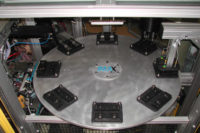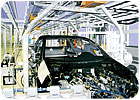
In his recent State of the Union address, President Obama challenged Americans to be more innovative. “We need to out-innovate, out-educate and out-build the rest of the world,” he proclaimed. “The first step in winning the future is encouraging American innovation.”
That means developing new materials, new products and new production processes. To tackle that challenge, manufacturing engineers must harness the power of “smart assembly” tools and systems. Leading manufacturers, such as Boeing and General Motors, are already using different aspects of the technology to gain a competitive edge.
The concept behind smart assembly was first proposed several years ago during a workshop hosted by the National Institute of Standards and Technology (NIST) and attended by a group of blue-chip American manufacturers. It focused on how to develop and integrate smart tools, such as flexible conveyors, feeders, fixtures, wireless robots, sensors, controls and intelligent fastening equipment, to address today’s endless product variety demands and subsequent workstation-level complexity.
Smart assembly is a concept that integrates production processes, people, equipment and information using both real and virtual methods to achieve dramatic improvements in productivity, lead time and agility.
“It goes well beyond traditional automation and mechanization to exploit the effective collaboration of man and machine in engineering and in operations,” says Bob Tilove, group manager of virtual manufacturing at GM’s Manufacturing Systems Research Lab. “It integrates highly skilled, multidisciplinary work teams with self-integrating and adaptive assembly processes.
“We’ve been on a journey for several decades, starting with CAD/CAM and computer-aided engineering,” adds Tilove. “As automation and computer technology continue to converge, it’s been a path of steady improvement.”
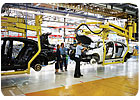
Sensors Play a Key Role
According to Tilove, smart assembly systems promise to usher in a sense, analyze, advise and respond environment on the plant floor. Sensors will monitor every parameter that is important to the operation, and control limits will be set for all parameters.“The state of the assembly will be evaluated at all times, and any deviations will be made known,” claims Tilove. “The assembly environment will function in a manner that is similar to the immune system of the human body, wherein anomalies that have no obvious symptoms are responded to in a very effective manner.”
“A smart assembly system can adjust and adapt itself to respond to changes in the production environment, such as variability of incoming parts and components,” notes S. Jack Hu, a professor of mechanical engineering and industrial and operations engineering in the College of Engineering at the University of Michigan. “The biggest benefit is robust performance to ensure quality and throughput.”
Smart assembly elements have already been applied to some production tools, such as fixtures, inspection systems and robots. “However, we still need more research at the systems level to make machines and subsystems work together,” Hu points out. “In addition, we need to make advanced technology more affordable to small- and midsized manufacturers.”
Boeing Commercial Airplanes is currently using smart assembly principles to implement a network-enabled manufacturing and operations (NEMO) initiative that is modeled on the U.S. Army’s Future Combat Systems program. The goal of the project is to bring state-of-the-art battlefield technology, such as “situational awareness,” to the assembly line.
Smart tools and sensors are the first layer of NEMO. Several applications are currently focused on 737 and 787 assembly processes, such as sealant cure-time monitoring. Drilling and installation tools have also been equipped with sensors that monitor user authentication, setup information, calibration status and interactive go/no-go functions. In addition, Boeing is using NEMO technology for some military applications, such as checking wire bundles on the F/A-18 fighter.
In the near future, Boeing engineers envision a widespread system that automates the movement of information between digital design tools and wireless production floor systems. Smart assembly applied to these processes will focus on creating intelligent tooling that doesn’t require operators to set limits or torques for a specific operation.
In the future, Boeing assemblers will refer to work instructions that are projected onto the wing or fuselage of an aircraft. Sensors embedded in fastening tools will guide assemblers, while laser images projected onto the airplane will automatically tell them where to position the correct part.
Electronic measurement and inspection systems will monitor and relay in-process information about every aspect of the assembly process. For instance, sensors will constantly monitor the performance of fastening tools, dispensing equipment, jigs, fixtures and other production equipment. Within the next decade, Boeing plans to expand the NEMO initiative to connect its engineers and assembly plants with customers and suppliers.
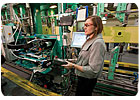
Extreme Manufacturing
Unfortunately, the smart assembly movement has been hampered by the recent recession. But, new efforts are underway to spur interest in pieces of the concept, such as digital manufacturing and virtual production. Earlier this year, NIST organized an “extreme manufacturing” workshop that was attended by more than 100 executives, including representatives from Boeing and General Motors.“Smart assembly is an integral part of extreme manufacturing,” notes Howard Harary, deputy director for manufacturing at NIST’s engineering laboratory. “Other key components are future intelligent manufacturing systems that address agility, responsiveness and simulation; affordability and sustainability; frontiers of manufacturing science, such as nanotechnology and self-assembly; and future manufacturing enterprise that addresses collaboration across complex, reconfigurable supply chains.”
Harary says the goal of the extreme manufacturing initiative is to “get people to think long-term about game-changing technology that levels the competitive field. The United States needs to offset the globalization of traditional manufacturing. We need to examine what technology can do in the future to make American manufacturers more competitive.”
Working with the Defense Advanced Research Projects Agency, the National Aeronautics and Space Administration, and the National Science Foundation, Harary and his NIST colleagues hope to create a long-range roadmap “on how to get from here to there.” As a followup to the recent workshop, they’re creating a new extreme manufacturing group on LinkedIn to spur additional dialogue on the topic.
Today, most smart assembly activity is focused on digital manufacturing and virtual production (DM/VP) technology. “Reducing the time and cost of product launch remains one of the biggest challenges for manufacturers,” notes Dick Slansky, a senior analyst at the ARC Advisory Group. “Many production system problems are not discovered until late in the design-implementation process, which introduces delays and costs.”
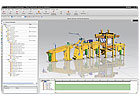
Speeding Time to Market
Proctor & Gamble Co., which manufactures batteries, razors and other consumer goods, is on the cutting edge of adopting DM/VP technology. “Unquestionably, the biggest benefit to DM/VP is speed-to-market,” says Tim Storer, P&G’s digital manufacturing product manager. “This benefit can emerge from several different sources, from accelerated validation to reuse of design knowledge to fewer prototype iterations. Ultimately, this allows firms to compress the delivery cycle without sacrificing quality.”
According to Storer, one of the key capabilities of DM/VP technology is real-time validation of design. “Models running in the background are able to analyze the current cross-functional design and flag issues before the design is complete,” he explains. “This allows knowledge-based decisions to be made as early as possible in the design cycle.
“DM/VP integrates mechanical, electrical and control systems by sharing common data in a neutral format or database,” adds Storer. “Accordingly, exchange of information is performed in real-time rather than during a discrete validation event.”
“Development methods that facilitate conceptualization of a system early in the design process and track functional requirements with the implementation are essential to reducing time to market,” says Slansky. “To address that need, we’re seeing the emergence of new software platforms that go beyond traditional product lifecycle management (PLM) programs. They bring together multiple elements, including virtual commissioning, and a closed-loop synchronization between physical production systems and upstream product design.”
For example, Siemens PLM Software, recently unveiled a software program based on computer game technology that makes it quicker and easier to design new machines and simulate their complex functions at an early stage. Depending on the task involved, the Mechatronics Concept Designer reduces development time by up to 20 percent. It makes it possible for all specialist departments to develop a machine together right from the start instead of successively, as was the case in the past.
Slansky says an interdisciplinary development platform enables engineers to evaluate various mechanical and electrical component designs jointly, long before any physical prototyping or testing is possible. For instance, a mechanical engineer can create a design based on 3D shapes and components, such as kinematics, gears and cams. Working on a collaborative simulation platform, an electrical engineer can select and position components such as sensors, actuators and servos. An automation and controls engineer can use the platform to design the basic logic control, as well as motion control programming. A
To learn more about cutting-edge manufacturing technology trends, click www.assemblymag.com and search for these articles:
-
Additive Manufacturing May Lead to New Assembly Paradigm
-
Smart Assembly Gets Cars on the Road Faster
-
These Seven Technologies Could Shape the Future of Manufacturing
- Wireless Technology May Let Robots Go Free

